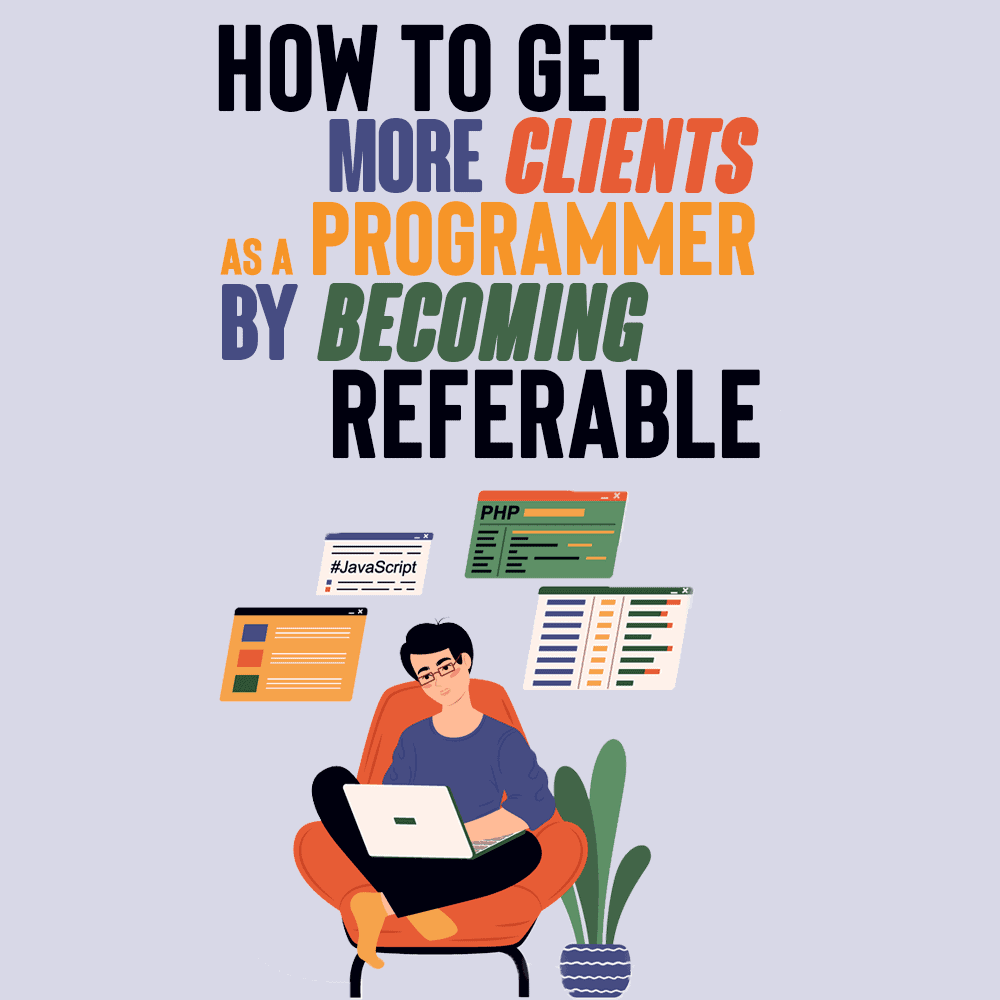 The pandemic and recession have led some programmers and developers to lose their jobs and clients this past year. Widespread vaccinations offer a light at the end of this long struggle, but the economy may not recover for quite some time.
The pandemic and recession have led some programmers and developers to lose their jobs and clients this past year. Widespread vaccinations offer a light at the end of this long struggle, but the economy may not recover for quite some time.
Despite the rising demand for programmers and developers, losing a longtime client can put a massive strain on finances even for the most skilled individuals. According to the Society of Human Resource Management, 28% of freelancers, or equivalent 10% of the U.S. labor force, have had to stop freelancing as a result of the COVID-19 crisis.
The future remains uncertain. Yet, it’s clear having more clients will help your business stay afloat. Working with different companies or clients means having more income sources and stability. So you’re more likely to survive the tough times in the foreseeable future.
How do you grow your client base? The answer lies in word-of-mouth referrals.
Why Is Word-of-Mouth Effective for Programmers?
Think about the last time you booked a hotel or visited a new restaurant.
A referral from your friend or family likely encouraged you to give it a go. They’re the ones we trust the most, and we want to use our hard-earned money on brands that they vouch for. They know our preferences, so their recommendation likely gave you the push you needed to try it yourself.
This is word-of-mouth marketing in a nutshell.
Referrals are trusted by 86% of customers, making it the most trusted form of marketing. Likewise, 59% of consumers enjoy talking about new products, which leads to 3.3 billion brand mentions in 2.4 billion brand-related conversations every day in America.
These statistics prove that word-of-mouth is a powerful tool for freelance programmers. Since people are more likely to trust recommendations from people they know, you can easily get referred leads through the sales funnel.
Not only are referrals great for leads, but recruiters often look for them when hiring on social platforms like LinkedIn.
How Do Referrals Work?
Referrals may happen organically. Your network utilizes word-of-mouth when they tag you in LinkedIn job posts or recommend your services. But referrals don’t always happen by chance.
Programmers may need to ask clients for referrals to receive one in return. However, getting referrals doesn’t happen overnight. Naturally, people only refer businesses that they trust. You’ll need to build relationships or provide quality service consistently to get on their good side.
How To Get Referrals From Your Current Clients
Getting referrals may take time, but it isn’t rocket science.
Here are some tips to consider when asking for referrals from current clients:
Deliver Great Work and Showcase It
People will only refer their network to skilled programmers or developers. So it’s important to deliver great work consistently. Besides the obvious—programming and developing skills—becoming a referable freelancer also requires managing multiple tasks at once. Use task management software to perform better and organize your work more efficiently.
Provide clients with a great customer experience. Understand their needs, provide solutions, and deliver what you promised. Doing so ensures that they are satisfied with your services.
After finishing a project, ask clients to write a testimonial that will be featured on your website or portfolio page. Featuring people that can vouch for your business will make your personal branding legitimate and referable. A noteworthy testimonial from a popular business in your industry could even help you clinch more clients along the way.
Ask for Referrals
As the popular saying goes, you need to ask for what you want.
Even if you offer 5-star services, clients won’t automatically make a referral. Instead, you need to be upfront and ask them to provide one.
Here’s an example of how you could bring it up in a meeting or conversation:
“Hi (client name!) I’m delighted to learn that you were satisfied with the results of our collaboration. Since things are going well, I was wondering if you know any businesses or colleagues that would benefit from my services?”
Some clients may not be able to guarantee a referral at the moment. And that’s perfectly fine. At the very least, they’ll know you’re in need of more clients and will likely make an effort to promote your business to contacts who may need it.
Send a Referral Email
Sending an email is a fast and nonintrusive way to get referrals from your clients. However, you don’t want to sound like a desperate sales rep. You’ll want to come off as authentic and genuine when making the request.
Here’s a sample email that you can send to bring it up:
Good day [client name]
Thank you so much for giving me an opportunity to work with your business on [ project or campaign ]. I’m happy to see that you’ve reached [insert milestones] quickly. I hope you’re delighted with my services.
In the upcoming months, I plan to grow my business. Since you’re satisfied with my recent results, I would like to know whether you have any business partners or colleagues that would benefit from my capabilities. I’m eager to help them achieve success.
Thanks,
[Your name]
Some clients may not reply to your email, and that’s OK. You can always follow up with them, but don’t be too persistent. Some clients may not know businesses or contacts in need of programmers at present.
You can check out the Networking Email Handbook by Rohan Mahtani and Email Templates for Networking and to Access the Hidden Job Market by Shireen DuPreez to find referral email templates you can use as inspiration.
Thank Referrals

It’s not easy to convince colleagues or friends to try something new regardless of the product or service. That’s precisely why you should thank clients who refer to your business.
Send an email to let them know that you appreciate their effort. If possible, invite them to a cup of coffee, or give them a gift as a kind gesture. Perhaps this will motivate them to keep referring potential clients or become loyal customers in the long term.
Offer Different Ways for Clients To Refer
What happens after clients make a word-of-mouth referral?
Having a referral process enables clients to introduce their referred friends to your services. Getting a referral may entail asking clients to fill out a form or send a private message or email whenever they want to refer their friends. With this strategy, you’re guaranteed to contact the referred friends, introduce them to your services, and onboard them.
A referral program will also help you automate the entire process. All you need to do is let clients sign-up for an account, create a referral landing page, and the tool does the rest. A referral program also gives you the option to offer rewards such as cash or discounts.
Refer Your Clients
Clients may not be motivated to refer to your services, and that’s perfectly fine.
Before you get a referral, you may have to make the first move and refer or promote the business of your clients first. Promote your clients via word-of-mouth to your friends, colleagues and others in your network.
When your referred friends end up as paying customers of your clients, it could motivate clients to return the favor and refer others your way.
Note that you should only recommend clients or businesses that you can testify to. After all, referrals can be a double-edged sword.
If you recommend your friends or colleagues and they have a bad experience with your client, then it may have a lasting impact on your personal relationships. That’s precisely why you should get to know your clients’ businesses first before you start referring them.
Ask at the Right Time
Timing is crucial to get a positive response to your referral request.
Keep clients updated on the results of your service. Monitor key performance indicators (KPIs), and inform them about milestones you’ve achieved, on a quarterly basis. If you’ve shared notable achievements on your project, then that may be the best time to ask for a referral. An alternative option is to ask when you’ve wrapped up your project and clients have expressed their satisfaction.
Building positive long-term business relationships takes time. It’s all right to hold on to the referral request, especially if you’re not confident about getting a positive response.
Ask for Feedback
Getting a referral entails satisfying your clients.
It’s difficult to gauge the needs of your clients, especially if those needs are based on your assumptions. That’s why it’s important to ask clients for feedback and communicate with them regularly.
Encourage them to fill out an online form such as a Google Forms or Typeform to rate your services. Don’t forget to include open-ended questions like “How can I improve as a programmer?” or “Do you have any comments about the services I’ve provided so far?”
Doing so ensures clients are satisfied with the services. They are unlikely to end the working relationship for unknown reasons. Asking for feedback also gives you the opportunity to resolve potential issues and find ways to improve your services for current clients.
Keep Your Business Growing by Generating Referrals
A referral is a fast and effective way to get more clients and grow your business.
A referred client already has a positive perception of your business, especially because it received praise from their trusted network. However, making yourself referable entails building trust and relationships with your current customer base.
You’ll need to deliver great work on a consistent basis and ask for feedback to ensure client satisfaction. When you’ve managed to build a good relationship with your clients, ask them for a referral, or refer others to their business first.
Once you have a strong referral process, you’ll be able to grow your client base and protect yourself from any unexpected economic downturns.
